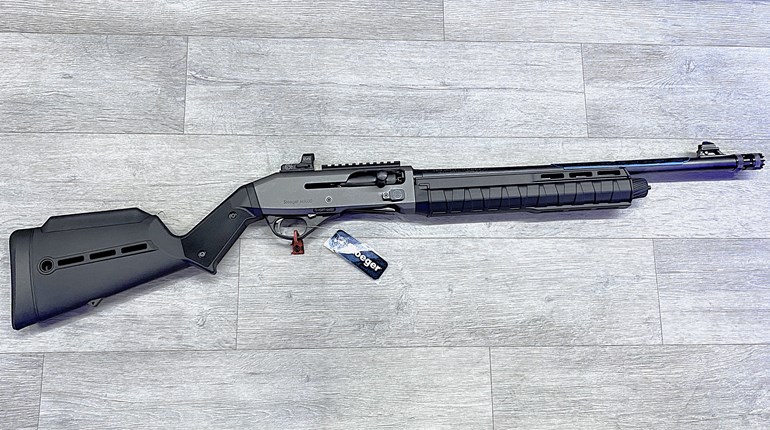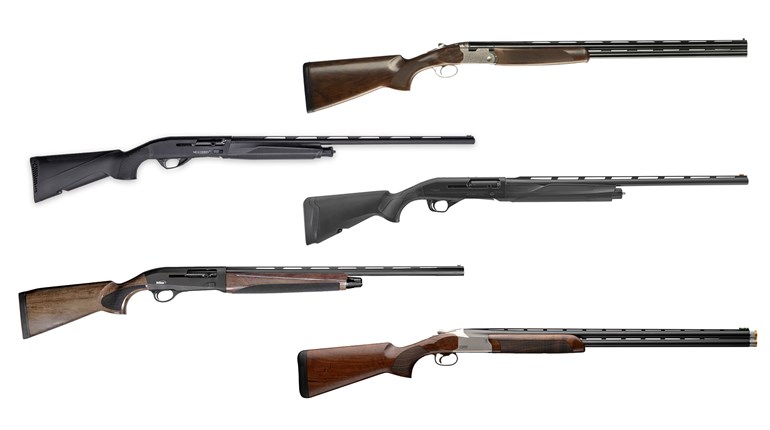
Above: Young shooters in the ATA’s youth program AIM (Academics, Integrity and Marksmanship).
Name a world championship sporting event where novices are encouraged to compete right alongside the best in the sport and both have a chance to win a world title. This event has been taking place each year, despite all imaginable types of world calamity, since 1900. The novices don’t have to “qualify” in the sport to compete in the event.
Give up? It’s the Amateur Trapshooting Association’s (ATA) Grand American Handicap event, held during the Grand American World Trapshooting Tournament every August since 1900.

Since 2006, the home of the Grand American has been the World Shooting & Recreational Complex in Sparta, IL. The Grand American Handicap is the final—as well as the most prestigious event of the annual world trapshooting tournament. A shooting extravaganza like no other, the tournament spans 11 days, features 24 shooting events (minimum of 100 targets each) with more than 4,000,000 clay targets taking to the air. The population of Sparta, IL, doubles when the more than 4,500 Grand American competitors come to town each August. Shotgunners of all ages from all over the world attend. The youngest competitor at this year’s Grand American was age 9, and the oldest 89.
A sport for all ages, trapshooting attracts both young and old shooters. Among the many age and class categories the ATA also offers a wheelchair category, giving an opportunity for military veterans and other disabled shooters to compete in a fun, recreational sport.

Trapshooters in the ATA use 12-gauge shotguns and fire at clay targets (approximately 4-1/4 inches in diameter and 1-1/8 inch in height) launched at varying angles. In singles events, all entrants stand at the 16-yard line and fire at one target at a time; in handicap, participants are assigned a yardage from 18 to 27 yards (according to averages and known ability) and fire at one target at a time; in doubles, two targets are released at the same time and each contestant, standing at the 16-yard line, is allowed one shot for each.
The Beginning
The first Grand American Tournament was held at the Interstate Park, Queens, NY, June 12-15, 1900. It was a mere coincidence that the first Handicap champion, Rollo Heikes hailed from Dayton, OH, just a few miles from where the Grand American would eventually find a home in 1924. With no permanent location, the tournament was nomadic in its infancy. In addition to New York City, early host cities included Kansas City, Indianapolis, Chicago, Columbus (OH), Springfield (IL), Dayton, St. Louis, Cleveland and Atlantic City.

In 1923, after the tournaments evolved in various ways, the Amateur Trapshooting Association was organized to replace the American Trapshooting Association. For the first time, trapshooting was run and organized by amateurs. The first Grand American under this new association was in Chicago, the last time it would be moved yearly.
Finally in 1924, the Grand found a permanent home in Vandalia, OH. In only four months, funds raised by the sale of life memberships made it possible to buy 62 acres, construct 16 trap fields and a clubhouse, which included the new offices for the ATA. Due to the distance to lodging in nearby Dayton, the ATA rented surplus army tents to shooters, and areas of the grounds became a tent city. Industry vendors at the Grand also set up tents to offer their products, and “Vendors Row” was born. Over the years, Grand attendance increased to more than 4,000 in the Grand American Handicap, running through more than 800 squads (five shooters per squad) in that event.

Since the beginning, patriotic trapshooters began each shooting day with the Star-Spangled Banner. As time went by and Canada became a big part of the association, the Grand and many other ATA tournaments began to play the Canadian Anthem first. The Grand has presented opening ceremonies since the old days of Vandalia. Such festive ceremonies have included parades, floats, marching bands, and in 1985, the Budweiser Clydesdales came in to perform a magnificent show for all Grand goers.
The Grand Now
In 2006, the World Shooting & Recreational Complex in Sparta became the permanent home of the Grand—with 121 trap fields that allow 605 competitors to be on the shooting line at the same time, more than the 528 that took part in the entire first Grand American Handicap event at Vandalia in 1924. The WSRC features 1,000 camp sites for today’s modern and fashionable RVs and over 4,000 parking spaces. A few of the vendors are still in tents, but many are located in stores in the five permanent vendor buildings, the vendor mall and in custom trailers and RVs. Anything and everything that has to do with trapshooting can be found at the Grand American. It doesn’t take very long for a new ATA member to add a trip to the Grand to their personal bucket list.

There are five championship matches within the 24 events of the Grand American World Trapshooting Tournament. Prestigious rings are awarded, similar to the Super Bowl. These championship events are: ATA World Clay Target Championship (200 singles targets), ATA World Doubles Championship (50 pairs of doubles targets), Grand American Handicap (single targets shot from handicap yardage, according to shooting ability), ATA All-Around (a total of the previous three events) and the ATA High-Over-All (1,000 targets of selected events). All the trophies awarded in all 24 events are of the highest caliber, such as silver loving cups, Shamrock Leathers shooting bags, and beautiful crystal items, to name a few. The numerous trophies are awarded in age and class categories as well as over the field.
Of the five coveted Grand ring events, only one ATA member has won all of them: Kay Ohye, formerly of Brunswick, NJ, now a resident of Odessa, FL. The 76-year-old senior veteran category competitor still continues to capture trophies over the field, beating all age groups. In the Grand’s long and storied history, no one has won the esteemed Grand American Handicap more than once.

Thousands of ATA members, industry representatives, family members and shooting enthusiasts have made the journey to the Grand for the last 117 years. Over the years, celebrity participants have included John Philip Sousa (also president of the Association in 1916 and 1918); Annie Oakley, who shot at the Grand American in 1925; and “King of the Cowboys” singer/actor Roy Rogers. Charlton Heston made several visits to the Grand American in Vandalia. With the grand opening of the Trapshooting Hall of Fame and Museum on the grounds of the WSRC in 2016, the history of this great American sport is now showcased in detailed display. Closely intertwined with the events of our nation for more than a century, anyone interested not only in the shooting sports, but in American history will be fascinated when visiting.

Dr. Tom Arvas, a member of the NRA Board of Directors and long-time trapshooter, was an ATA state delegate for about 16 years—becoming the president of the ATA in 2005.
“It was a big deal for me to become president of a group I started with when I was very young,” said Dr. Arvas. “Trap shooting has been around for 130 years. Now there are different types of people involved with the sport, which is exciting.”
New friendships and memories are made each year at the Grand American World event. Win or lose, good times with family and good friends are always in store at the Grand.
A lifelong sport, people from all walks of life, all ages, entire families participate in ATA trapshooting. The sport’s stats and records are chronicled and maintained by Trap & Field, the official magazine of the ATA. If you are interested in trying trapshooting, please call the ATA at 618-449-2224 or visit the association’s website (www.shootata.com) to find one of the 2,000 local ATA clubs near you. For more historical information, please visit the Trapshooting Hall of Fame website at www.traphof.org.


































